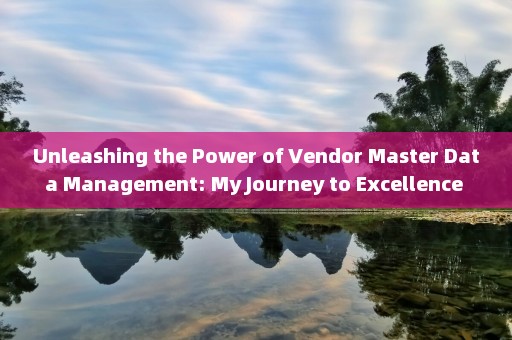As a specialist in the field of vendor master data management, I've seen the impact it can have on businesses. Picture this: a bustling office where data streams in from countless vendors, each with their unique sets of information. In the midst of this chaos, I've learned to harness the power of best practices to create a symphony of organized, actionable data. Join me on this journey as I share my insights and experiences to help you achieve the same level of mastery.

Understanding the Basics: What is Vendor Master Data Management?
Before we dive into the best practices, let's establish a solid foundation. Vendor master data management (VMDM) involves collecting, validating, and maintaining all the data related to your organization's suppliers. This includes information such as vendor names, contact details, payment terms, and product or service offerings.
Effective VMDM ensures that your company has accurate, up-to-date information about its suppliers, enabling better decision-making, streamlined procurement processes, and improved supplier relationships.
My Top 5 Best Practices for Vendor Master Data Management
1. Develop a Robust Data Governance Framework
A solid data governance framework is the cornerstone of successful VMDM. It defines roles, responsibilities, and processes for managing vendor data. Here's how I've seen it done right:
- Establish a Data Governance Council: Create a cross-functional team responsible for overseeing vendor data management. This council should consist of representatives from procurement, finance, IT, and other relevant departments.
- Define Data Standards: Set clear guidelines for data quality, format, and usage. This ensures consistency across the organization and makes it easier to integrate vendor data with other systems.
- Implement Data Validation Rules: Use automated tools to validate vendor data against predefined rules. This helps identify and correct errors or inconsistencies in real-time.
2. Streamline Vendor Onboarding
Vendor onboarding is a critical aspect of VMDM. It's essential to make this process as efficient as possible to avoid delays and maintain data accuracy. Here's a strategy that's worked wonders for me:
- Standardize Onboarding Forms: Create a single, comprehensive form that captures all necessary vendor information. This reduces the likelihood of missing or duplicate data.
- Use Electronic Signatures: Implement electronic signature solutions to expedite the onboarding process. This eliminates the need for physical documents and speeds up approvals.
- Automate Data Entry: Leverage technology to automate data entry wherever possible. This reduces manual errors and ensures data integrity.
3. Foster Collaboration with Vendors
Collaboration is key to maintaining accurate vendor data. By working closely with your suppliers, you can ensure that information remains up-to-date and reliable. Here's how to foster collaboration:
- Regular Communication: Schedule regular meetings or check-ins with key vendors to discuss updates to their information. This helps build strong relationships and keeps data accurate.
- Self-Service Portals: Implement self-service portals where vendors can update their own information. This empowers suppliers to take ownership of their data and reduces the burden on your team.
- Feedback Loops: Encourage vendors to provide feedback on your data management processes. This can help identify areas for improvement and strengthen your partnership.
4. Leverage Technology to Enhance Data Management
Technology plays a crucial role in VMDM. By leveraging the right tools, you can automate processes, improve data accuracy, and gain valuable insights. Here are some technology-driven best practices:
- Implement a VMDM Solution: Invest in a dedicated VMDM solution that centralizes vendor data, automates workflows, and provides reporting capabilities. This streamlines processes and enhances data visibility.
- Data Integration: Ensure your VMDM solution integrates with other business systems, such as ERP or procurement software. This enables seamless data flow and eliminates silos.
- Analytics and Reporting: Use analytics tools to gain insights from your vendor data. This can help identify trends, potential risks, and opportunities for cost savings.
5. Continuous Improvement: The Path to Excellence
Vendor master data management is not a one-time project but an ongoing process. To achieve excellence, it's crucial to embrace continuous improvement:
- Regular Audits: Conduct regular audits to assess the quality and accuracy of vendor data. Use these findings to make necessary adjustments and enhancements to your processes.
- Employee Training: Invest in training programs to ensure your team understands the importance of VMDM and knows how to execute best practices effectively.
- Stay Updated: Keep abreast of industry trends, regulations, and technological advancements. This will help you adapt your VMDM strategy as needed and maintain a competitive edge.
Conclusion
Vendor master data management may seem like a daunting task, but with the right approach, it can transform your procurement processes and supplier relationships. By following these best practices, you'll be well on your way to achieving excellence in VMDM.
Remember, the journey to mastery is filled with learning, adaptability, and continuous improvement. Embrace these principles, and you'll unlock the true potential of your vendor data.
Post a comment

Comment List